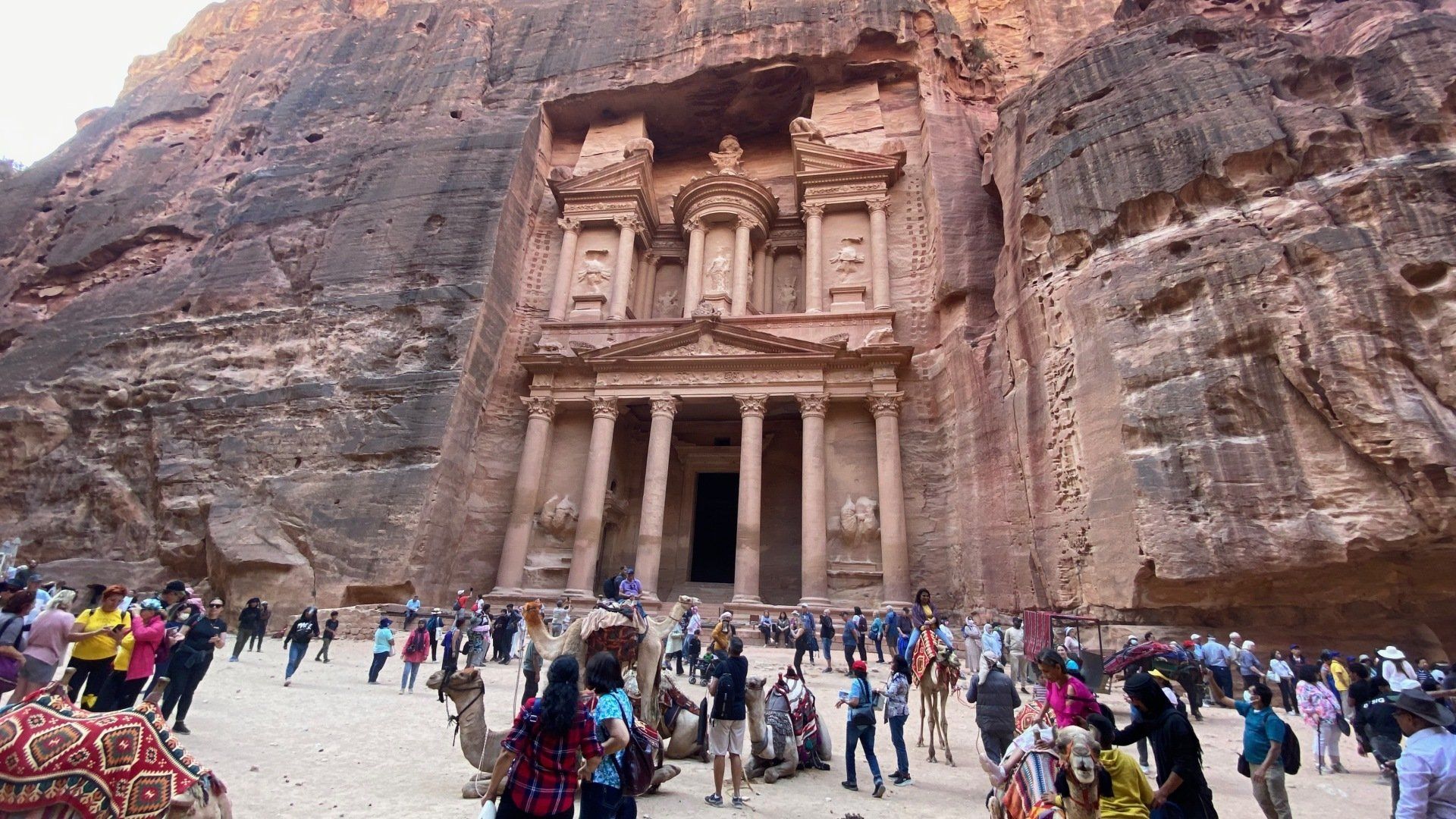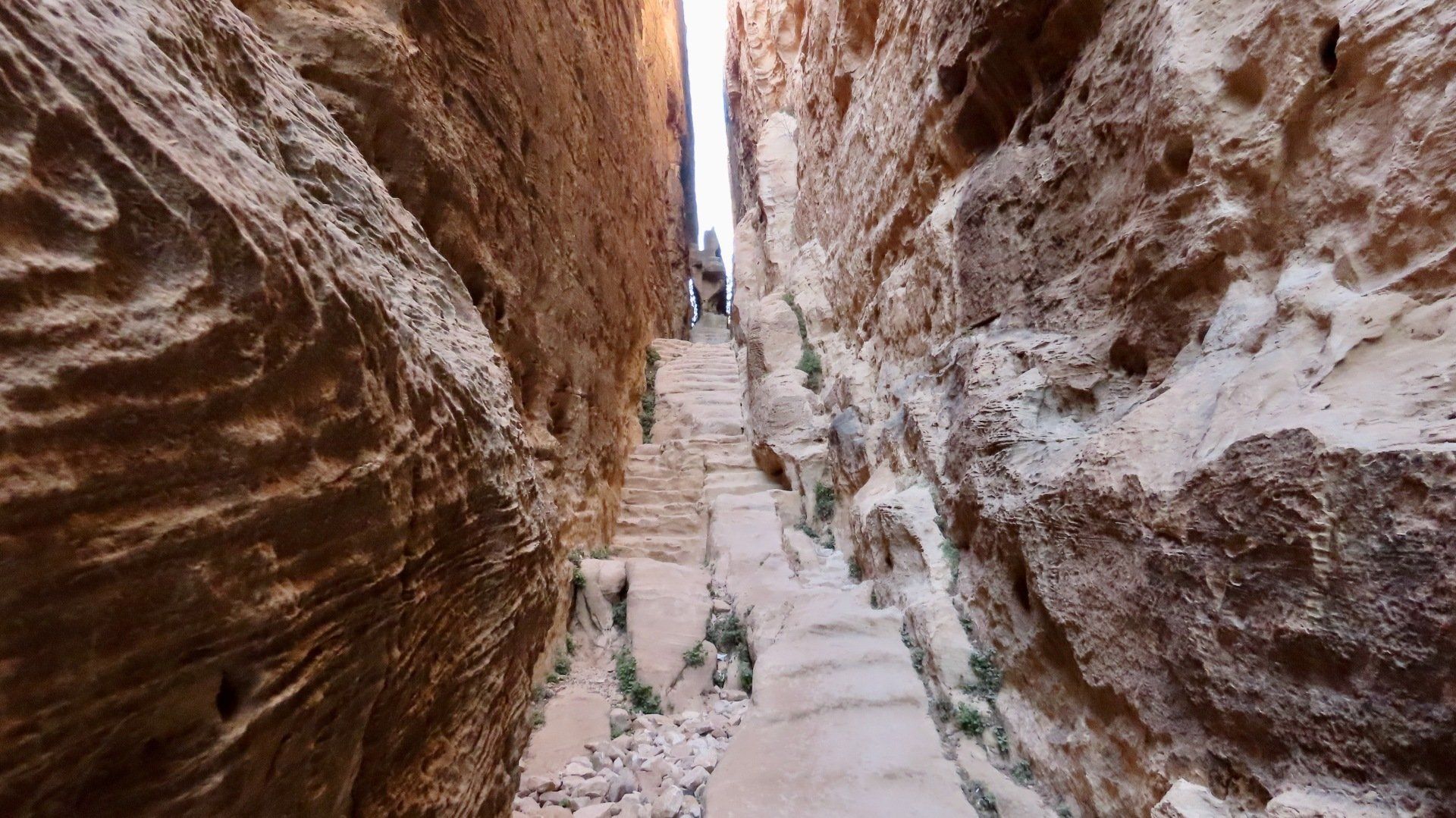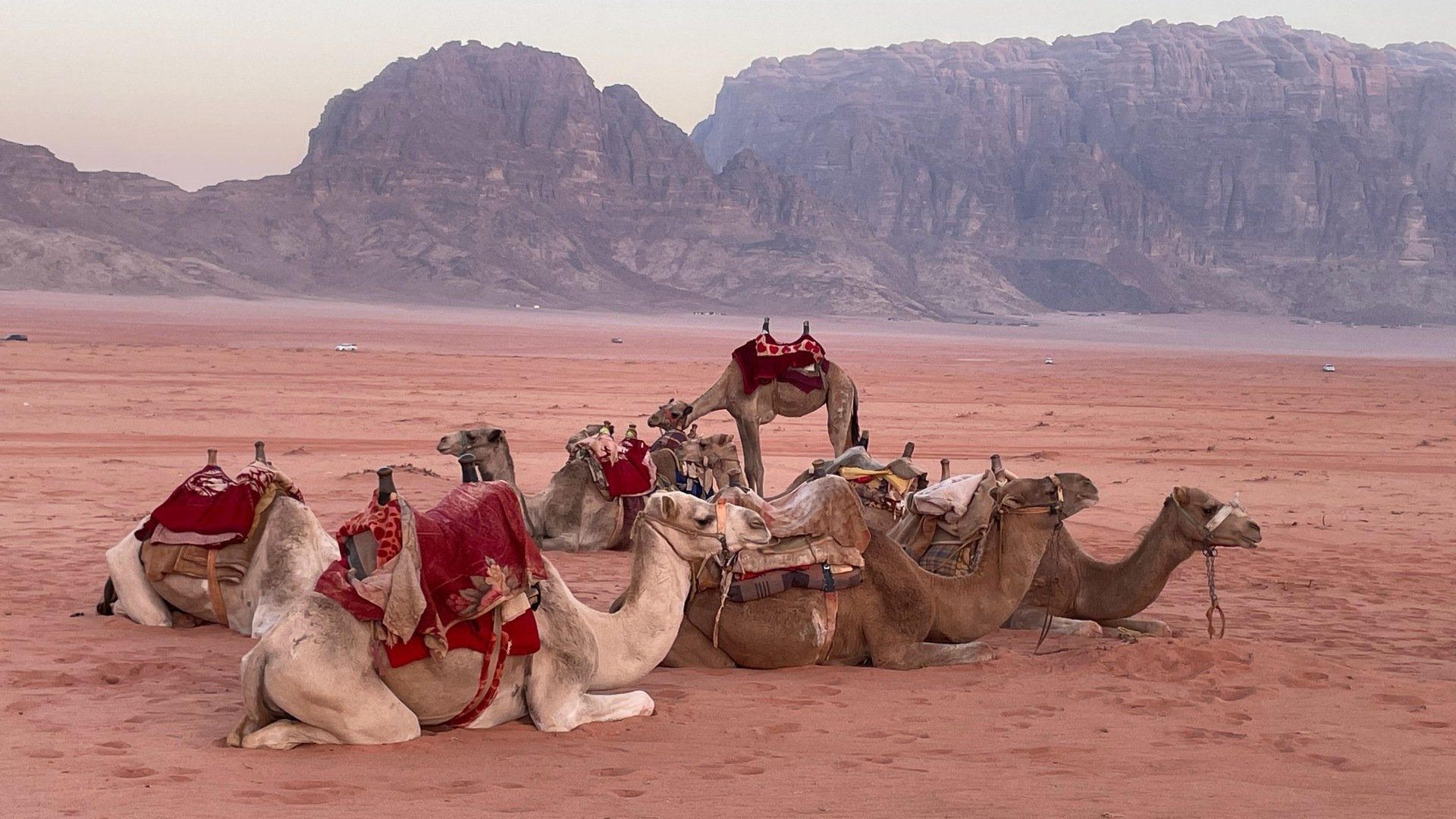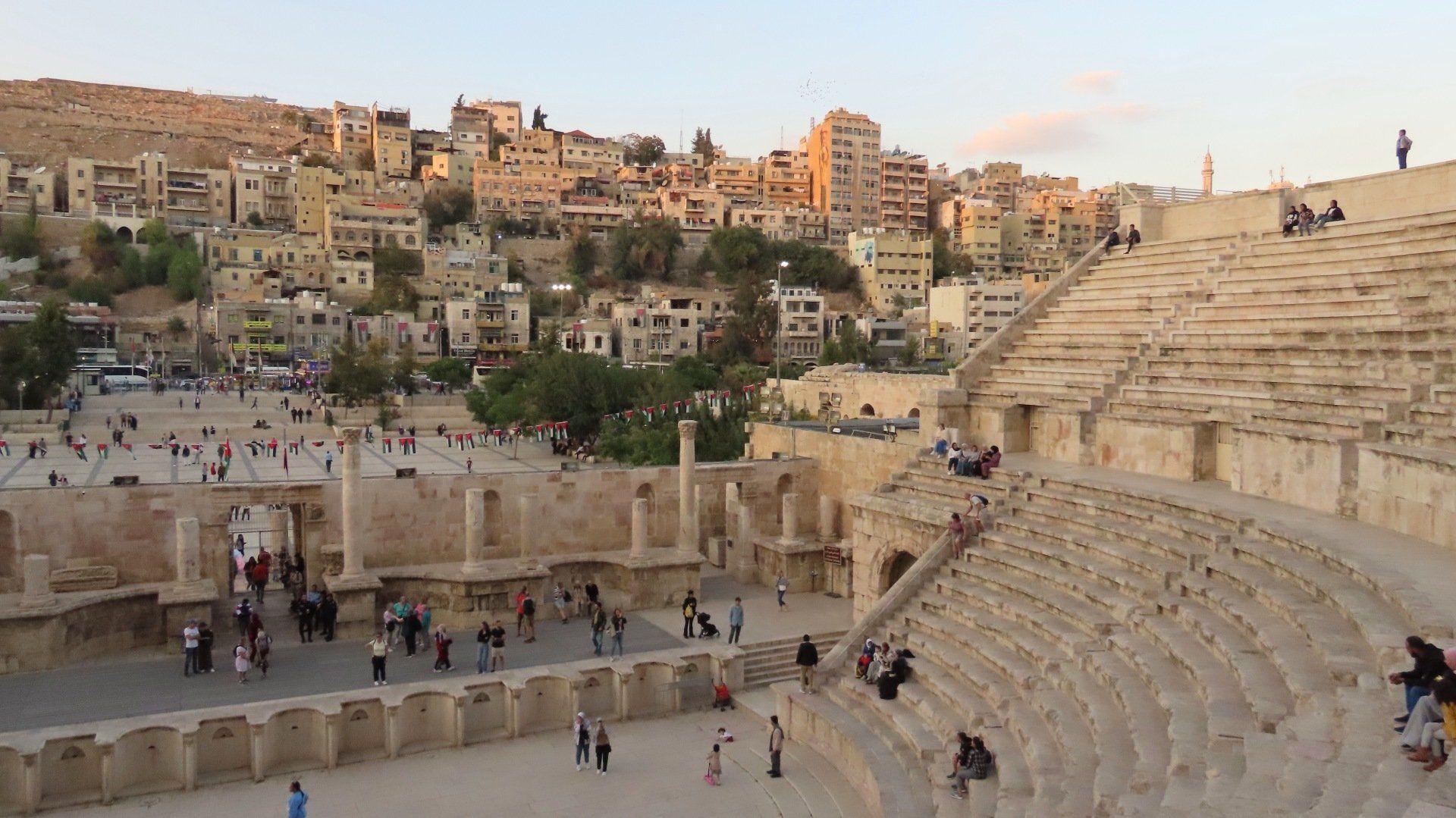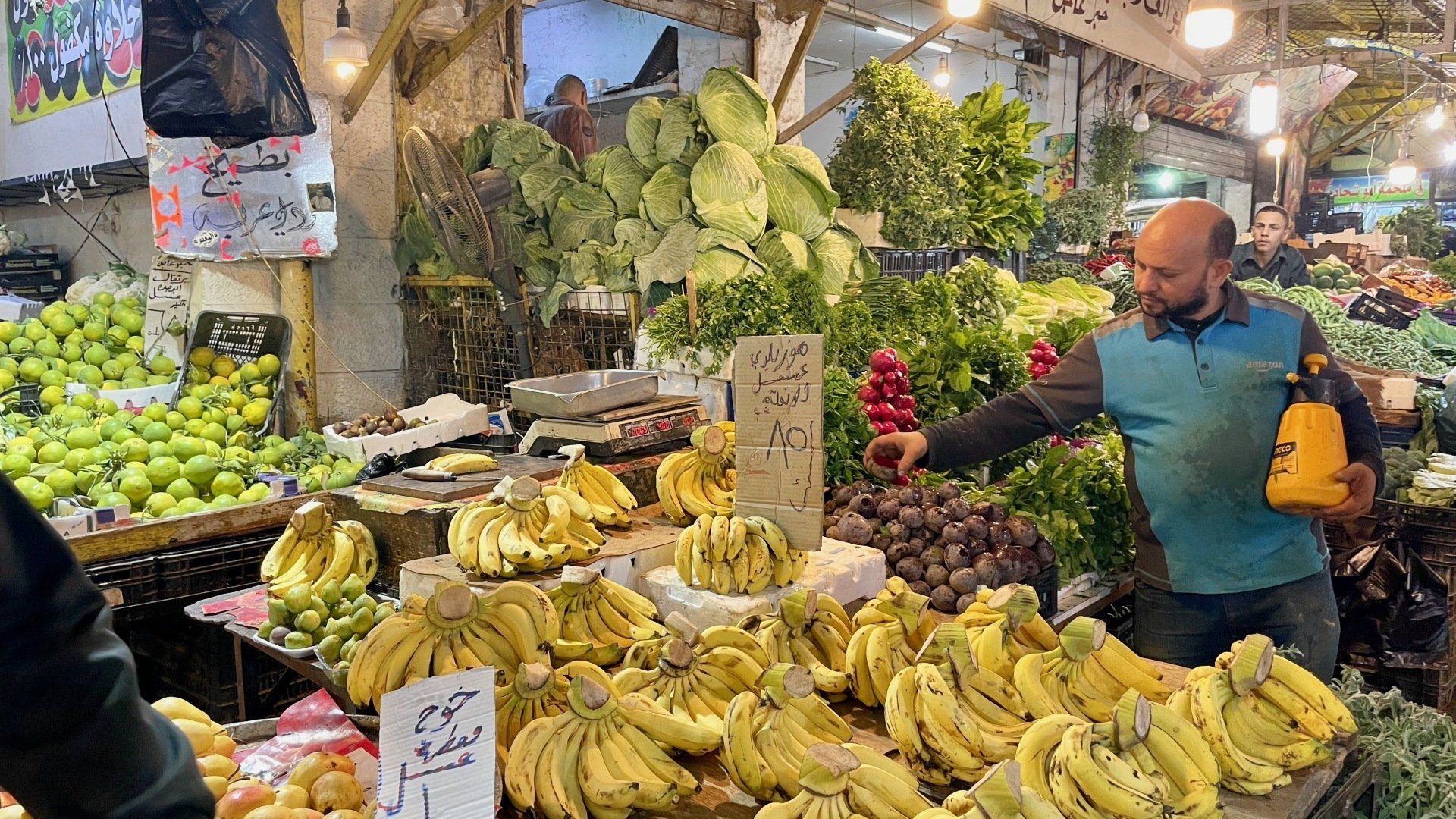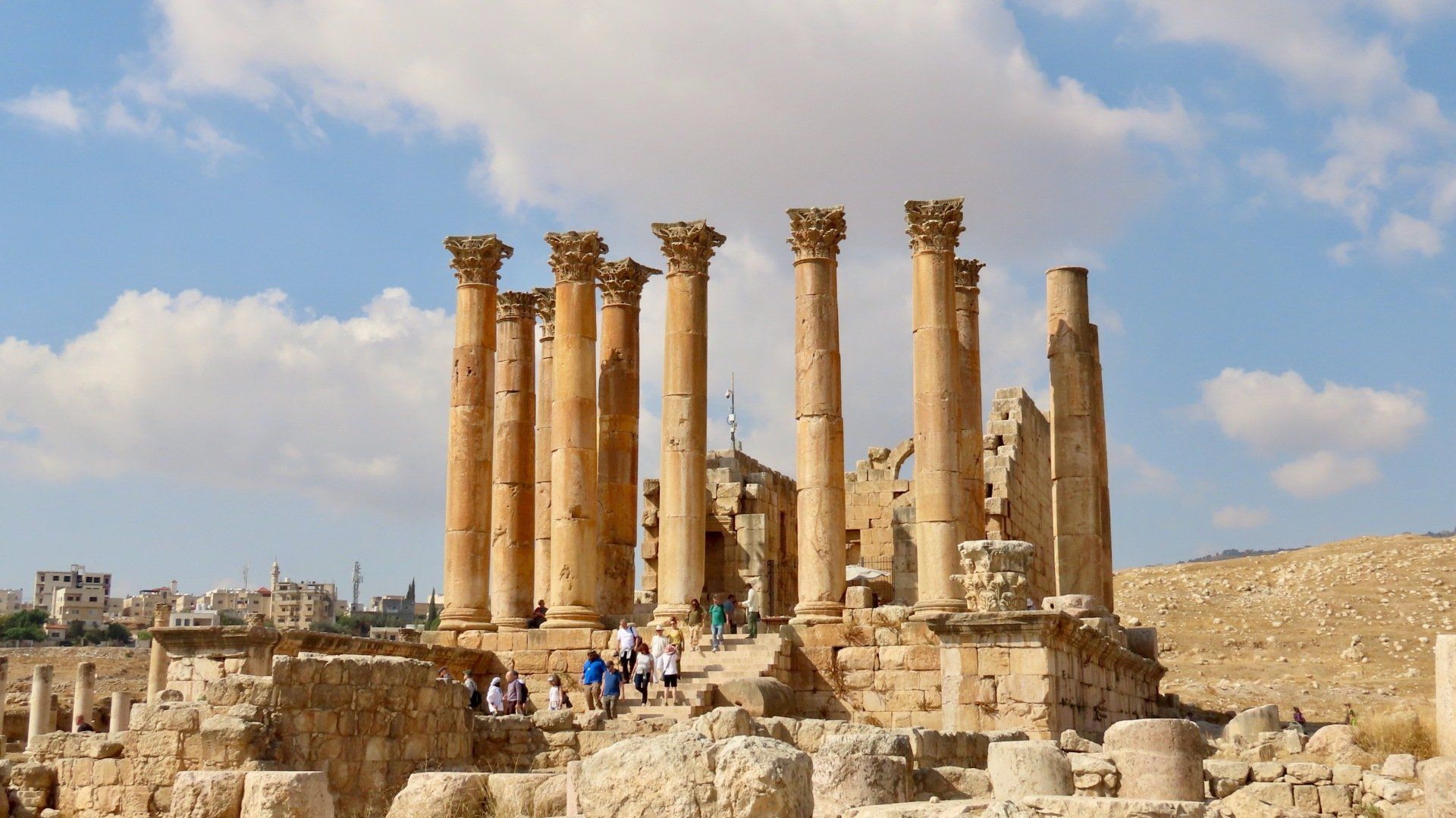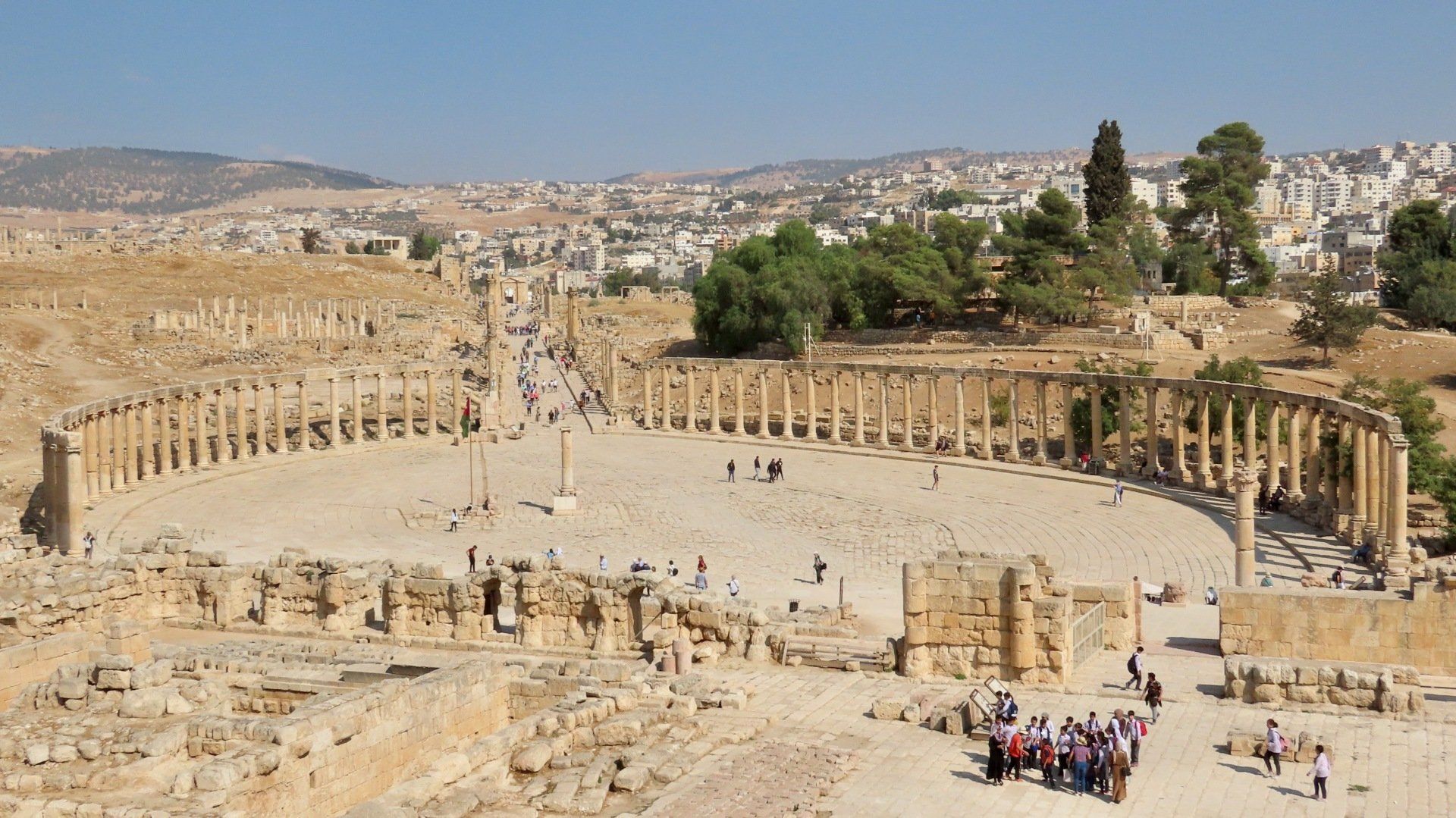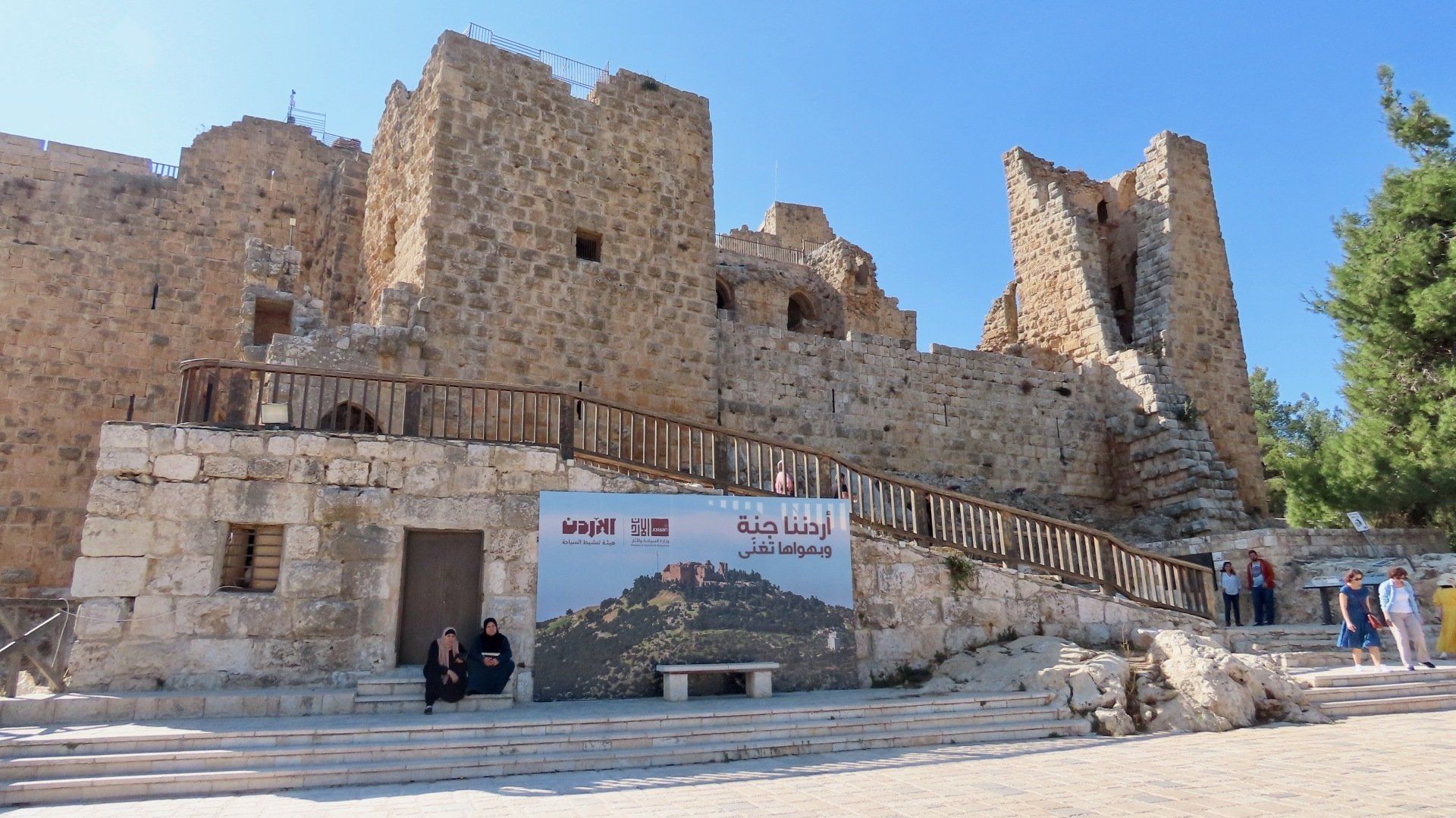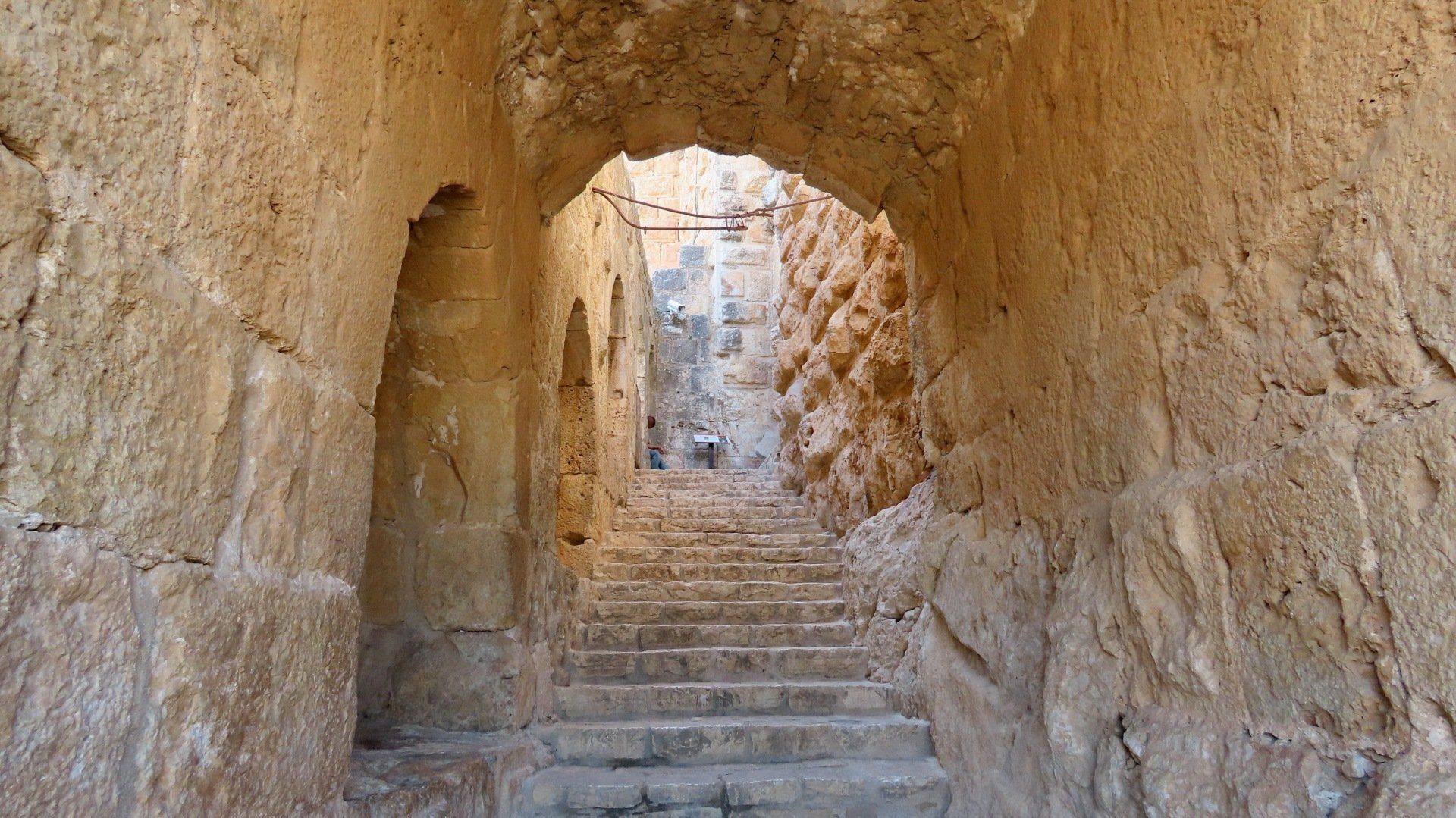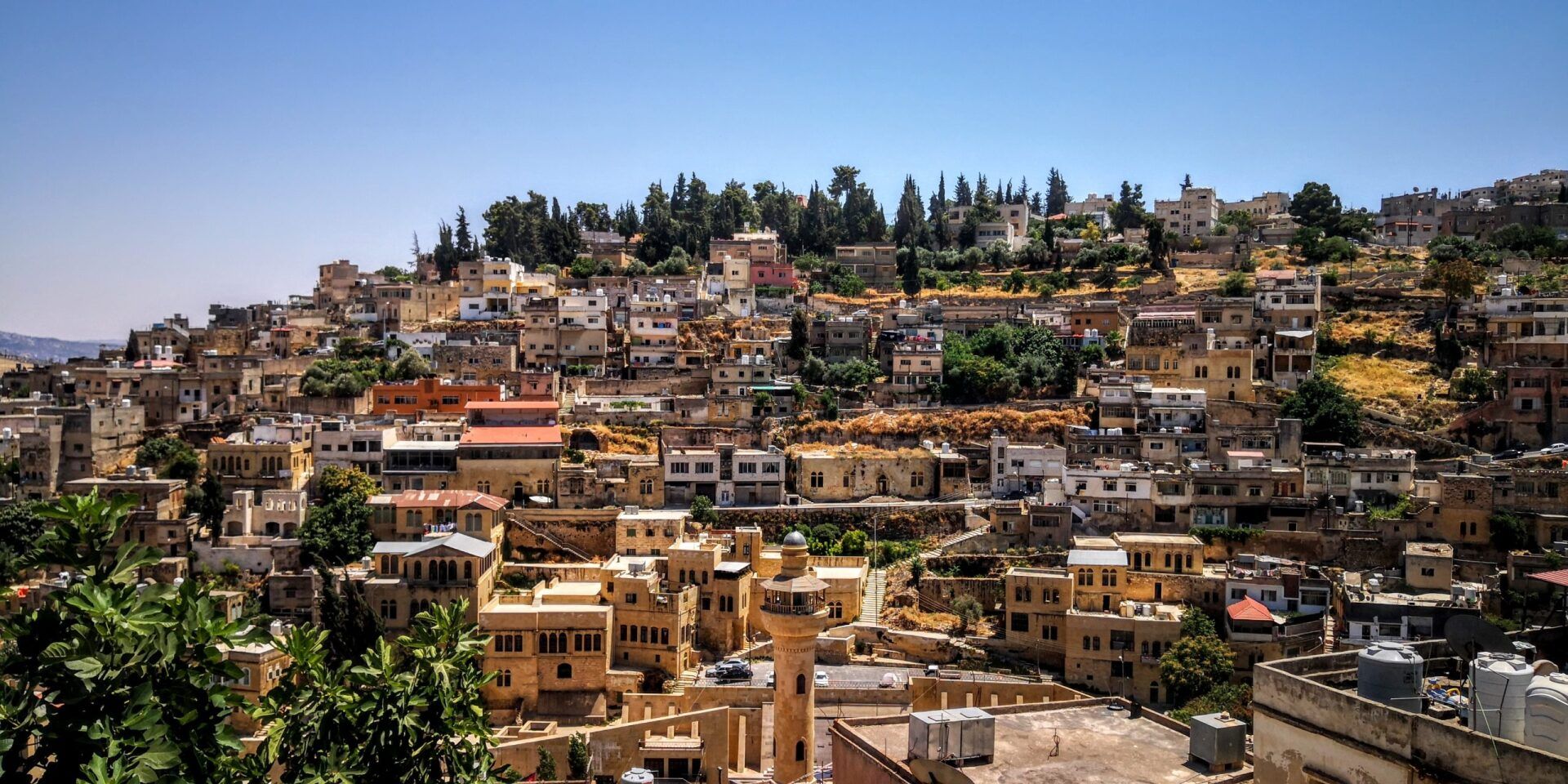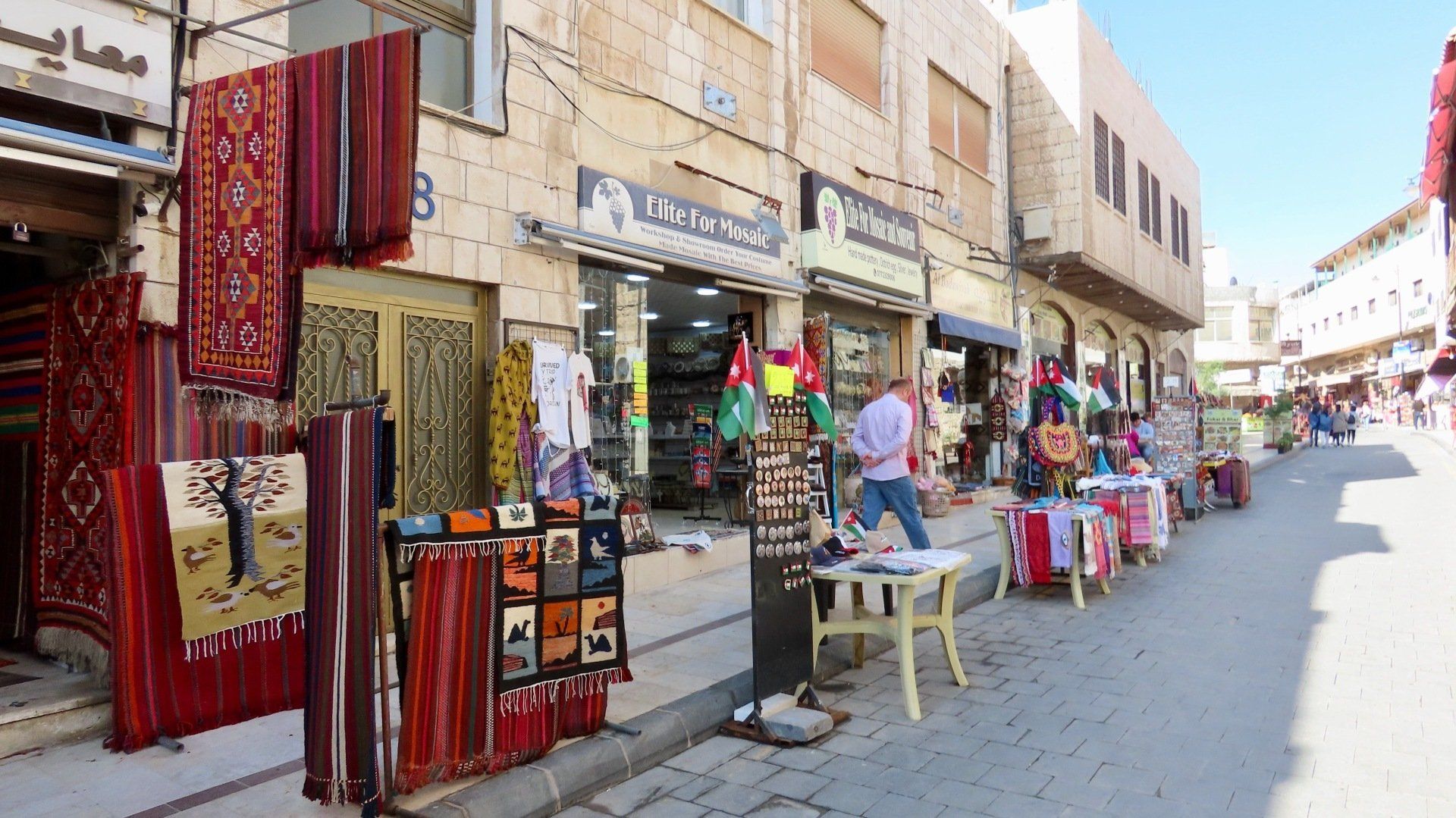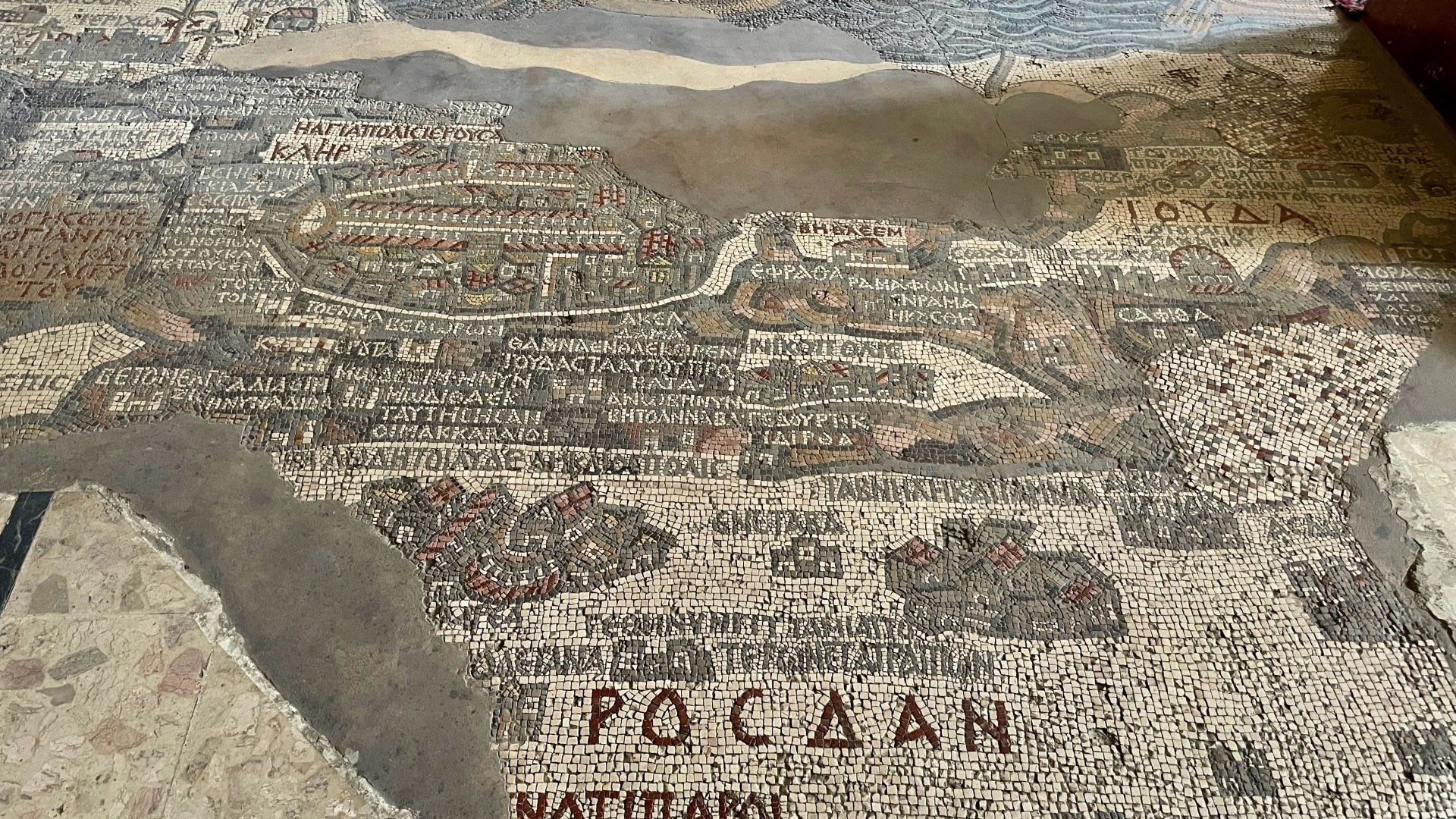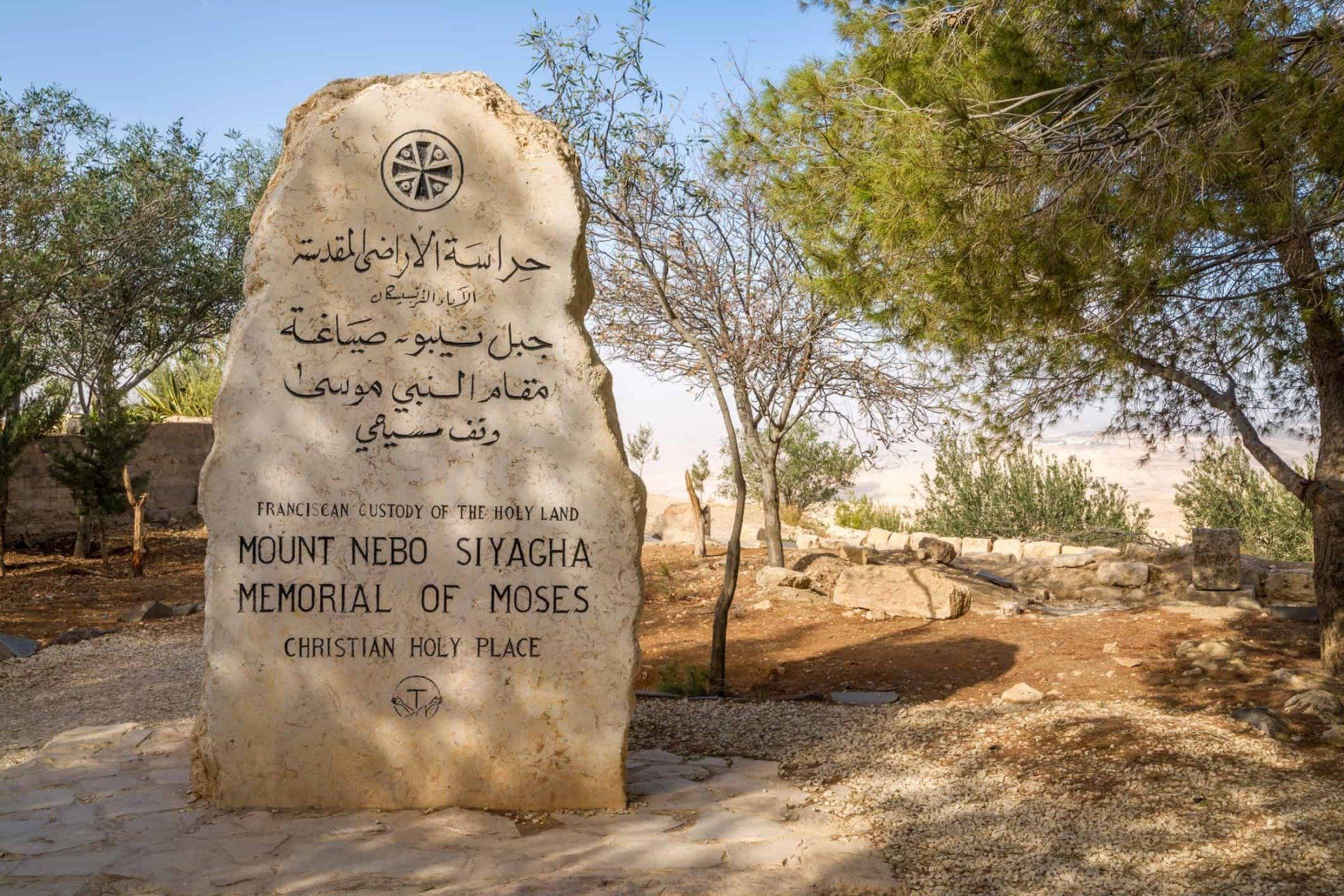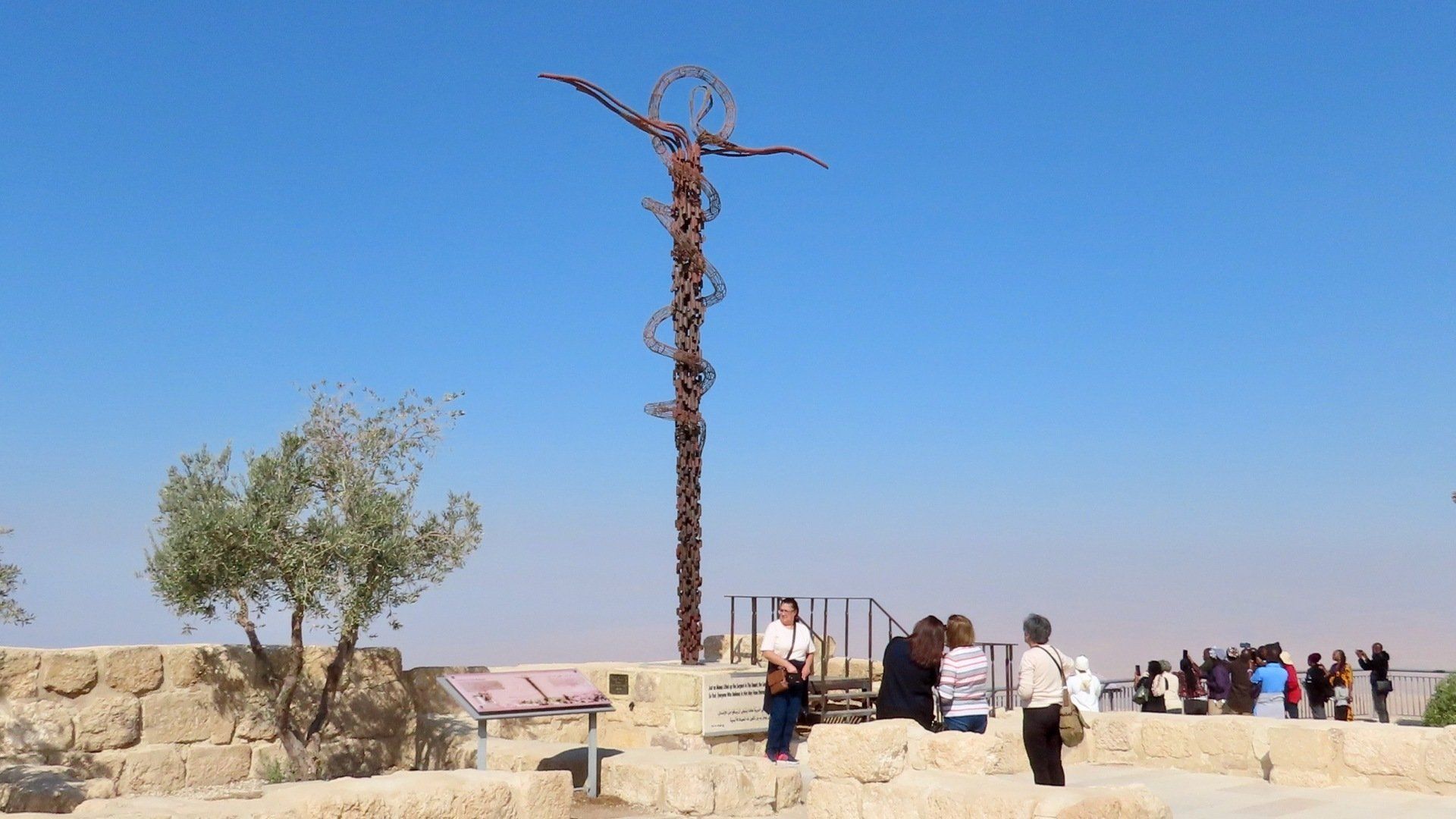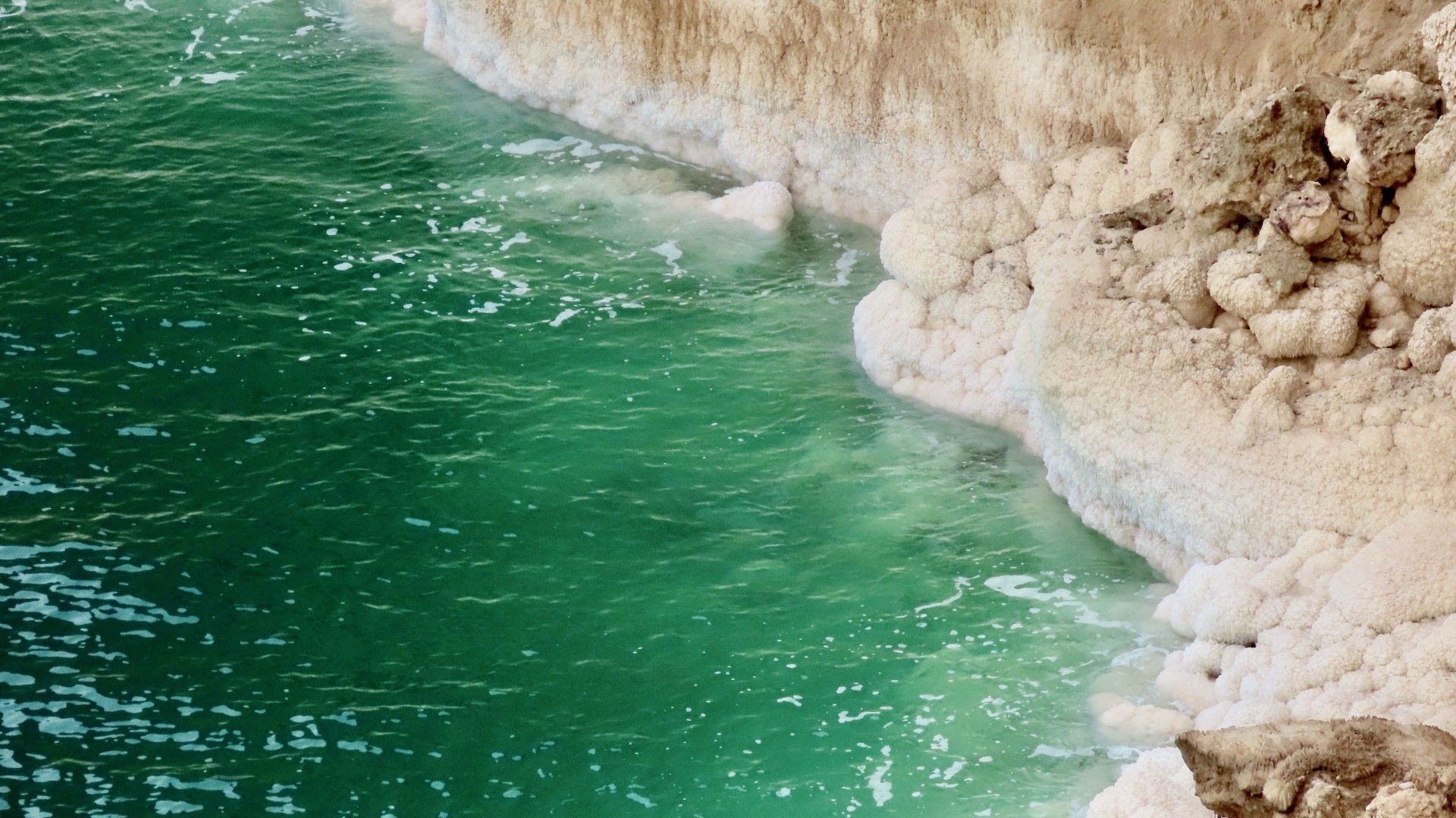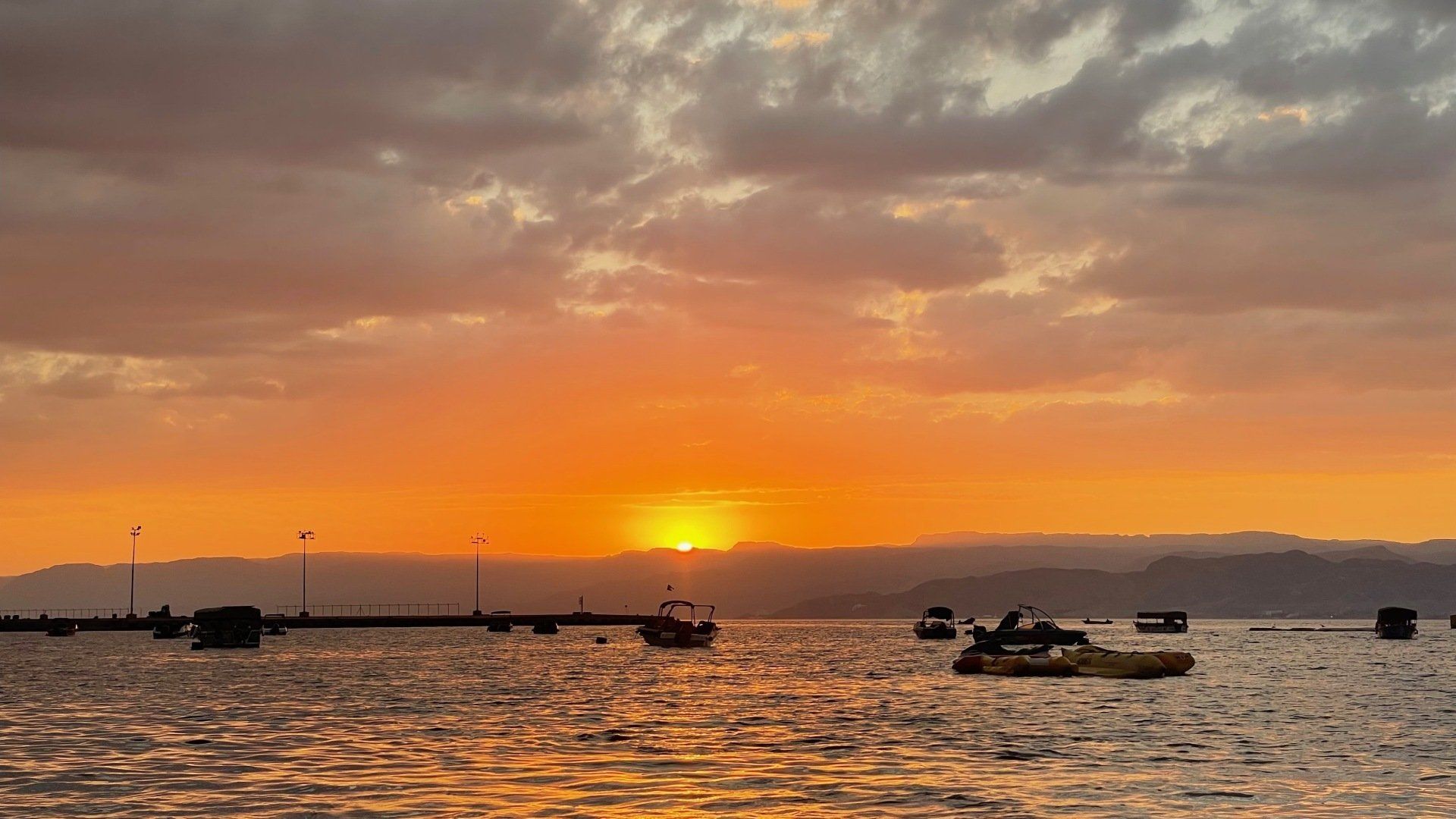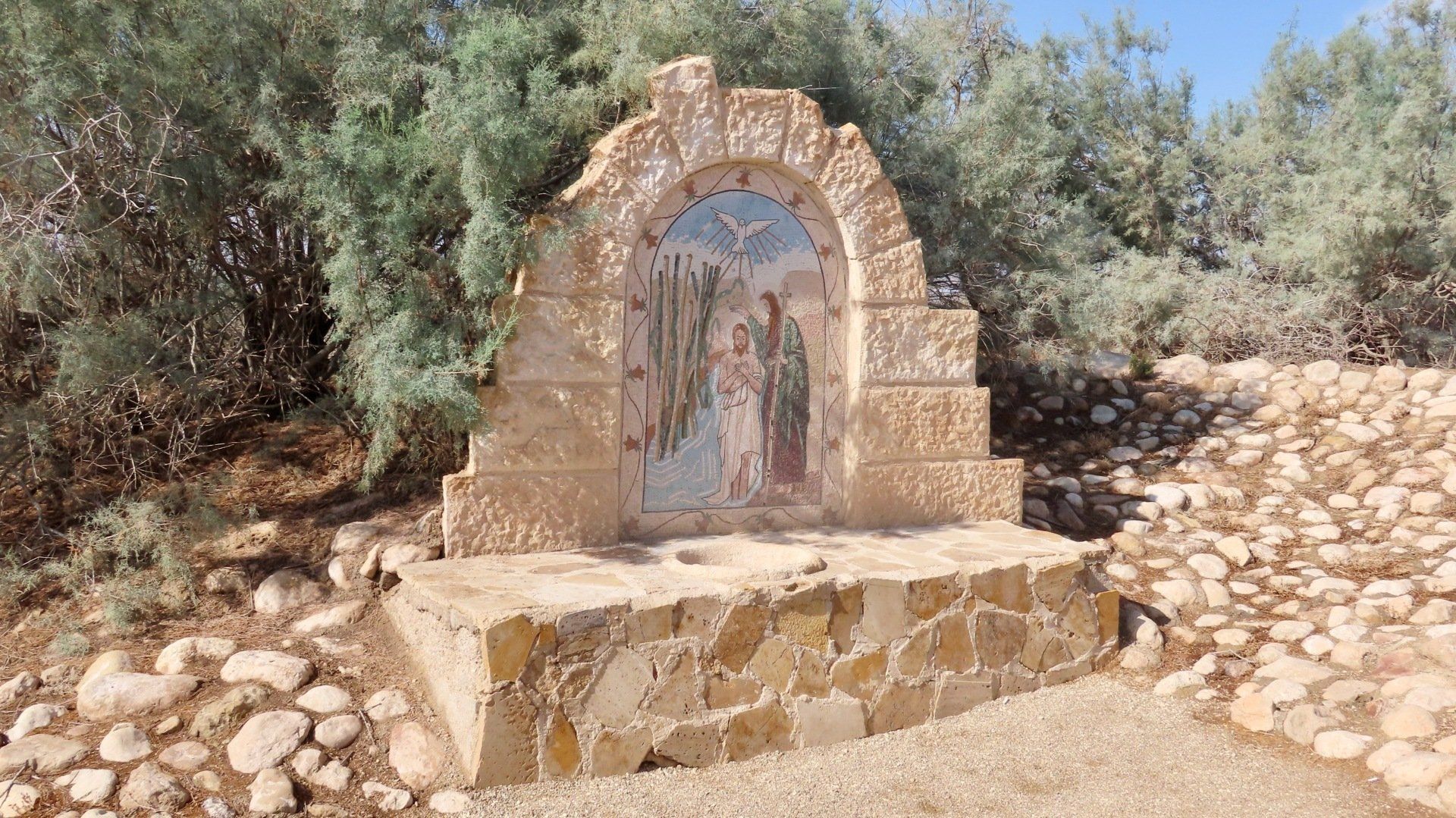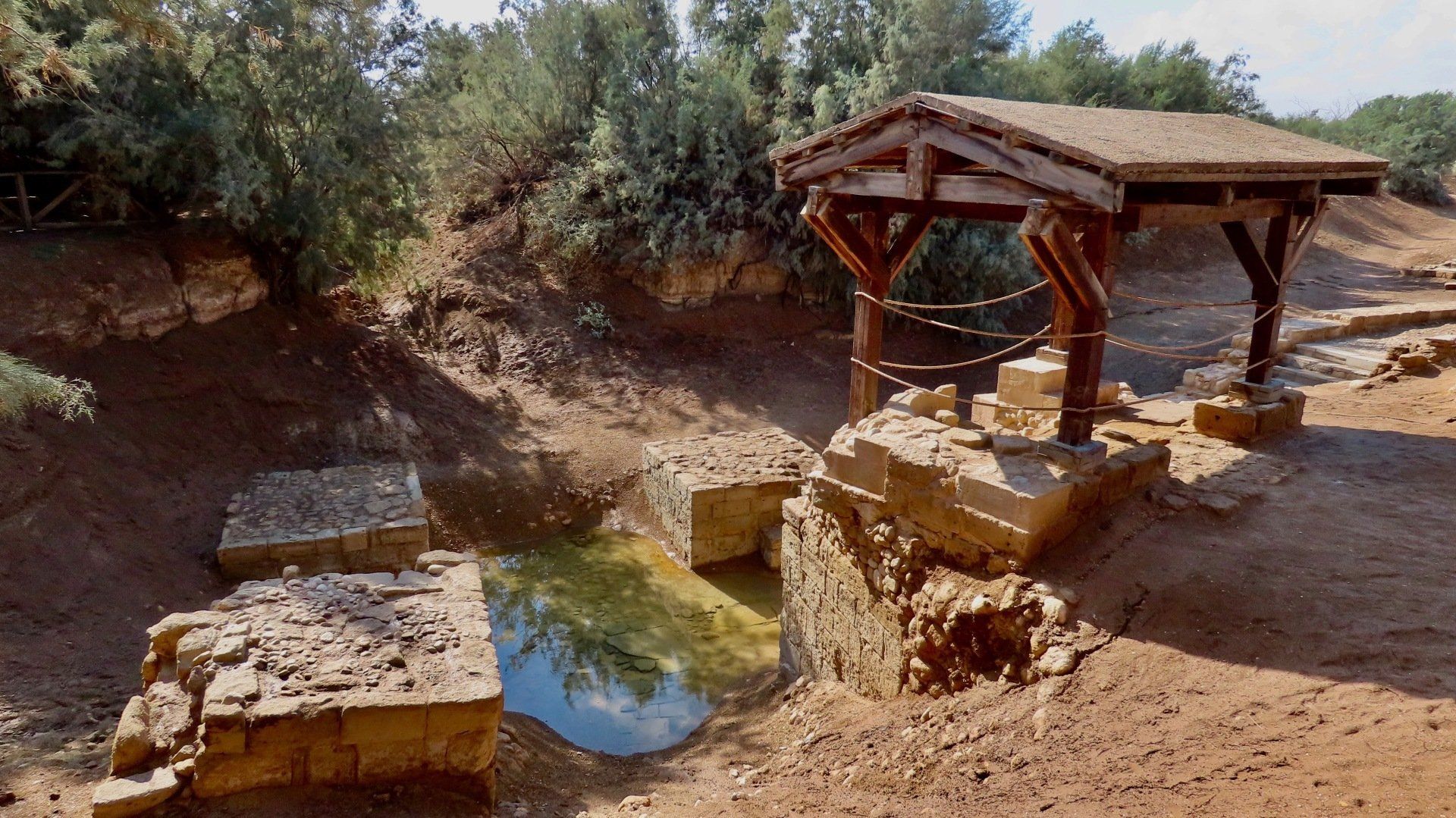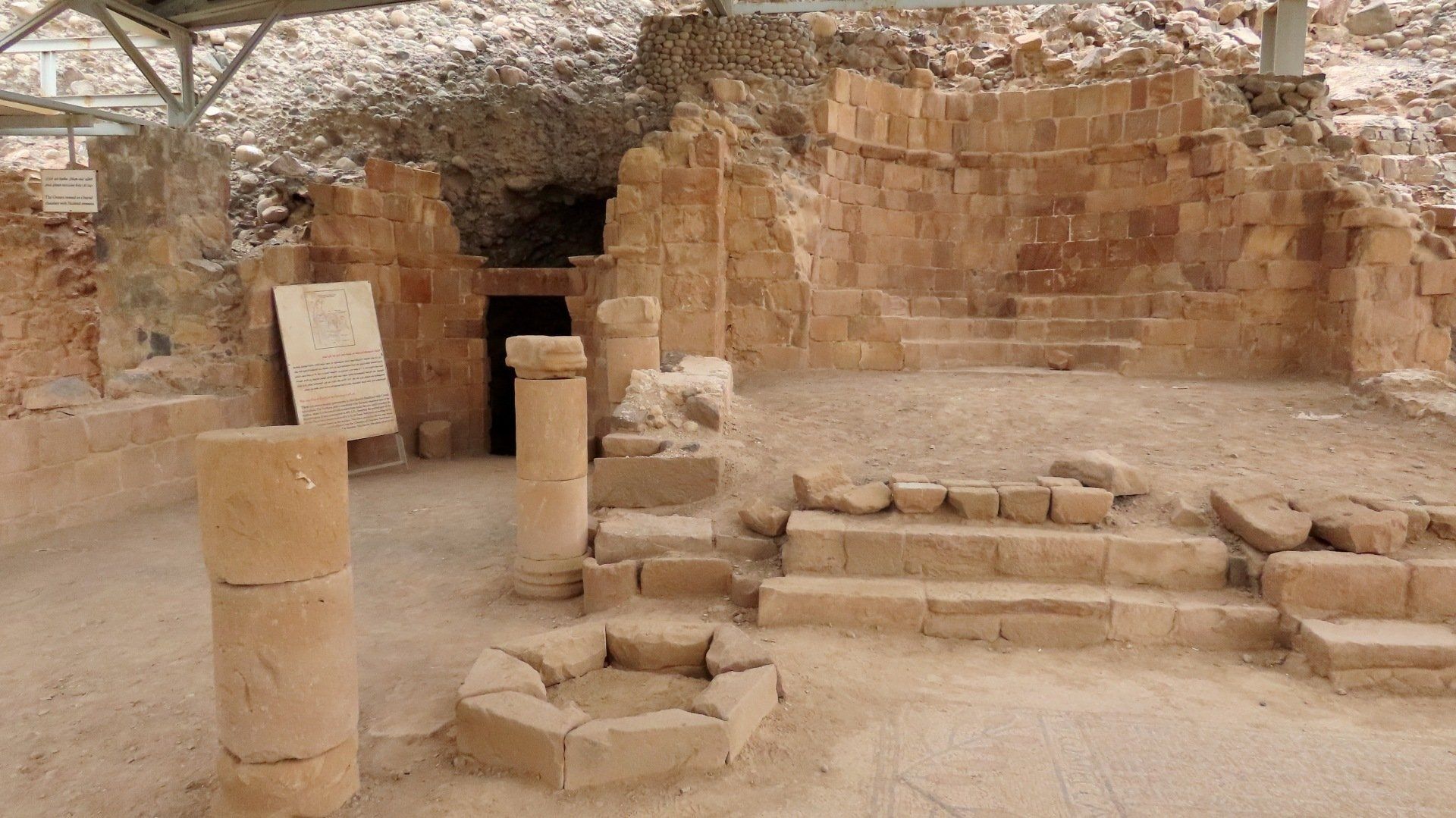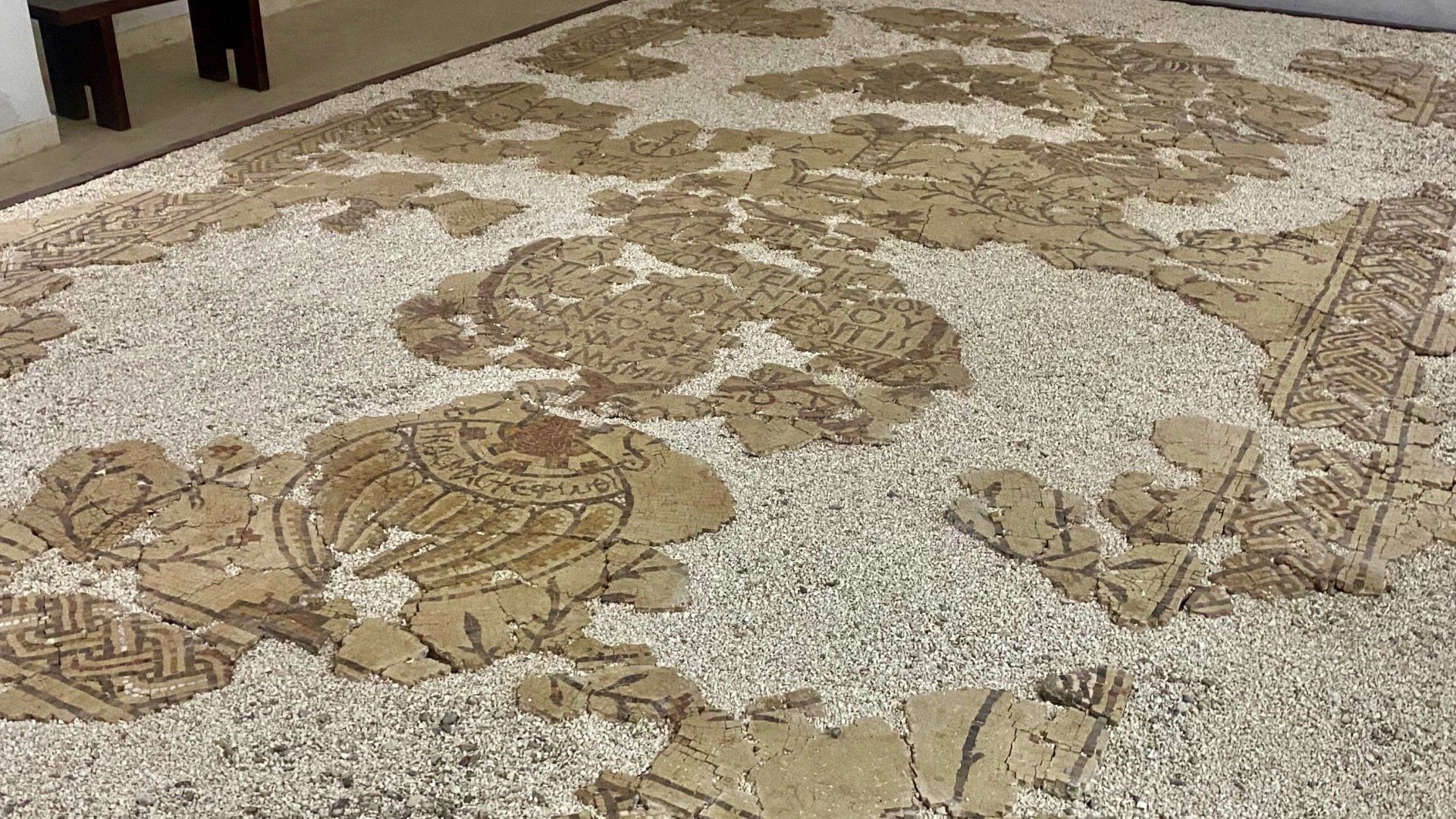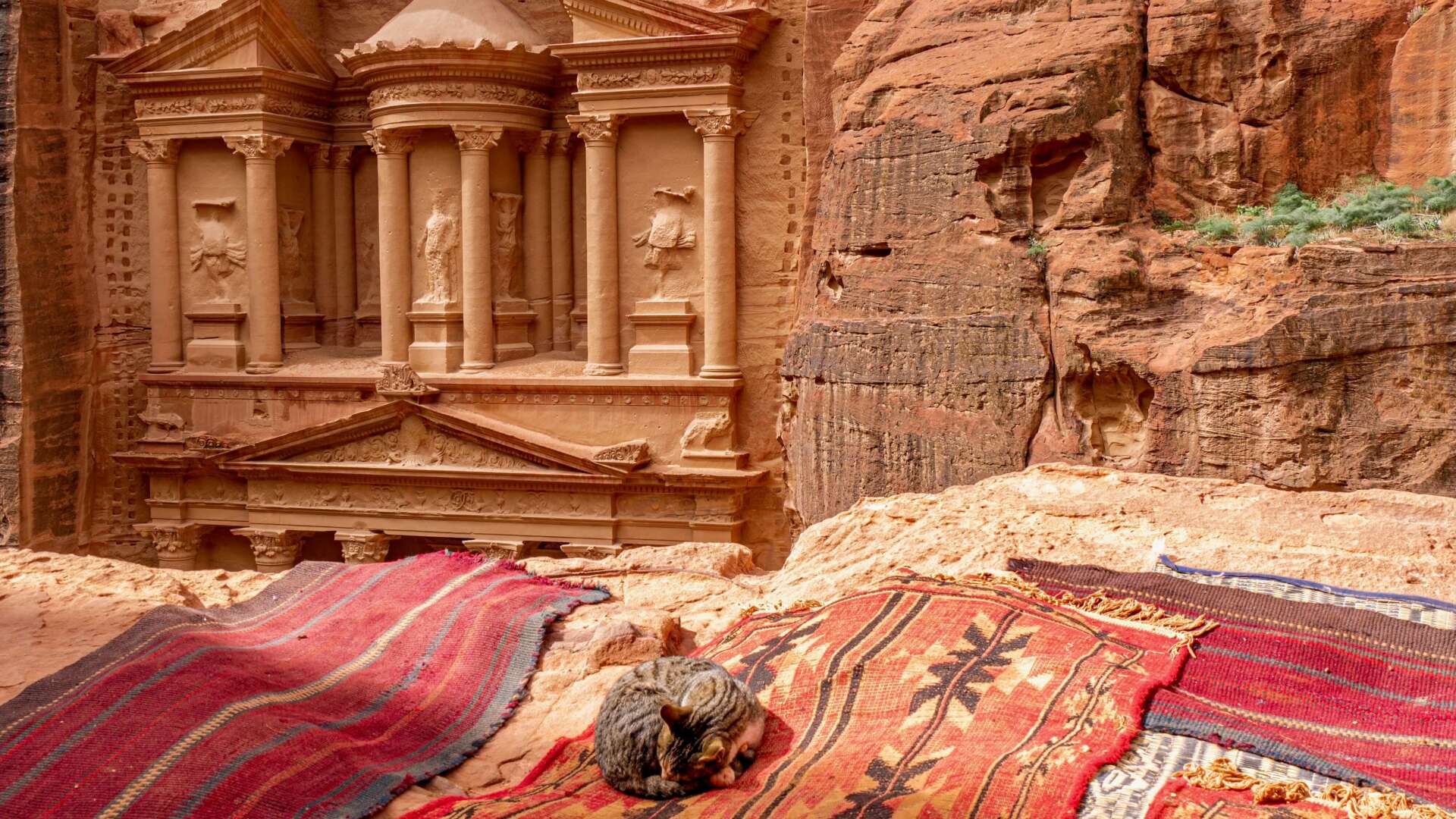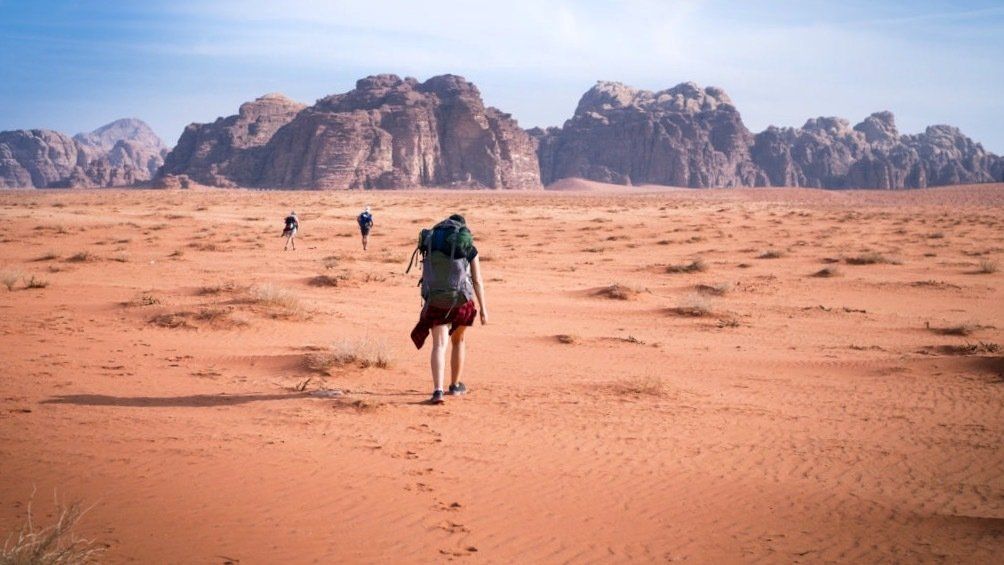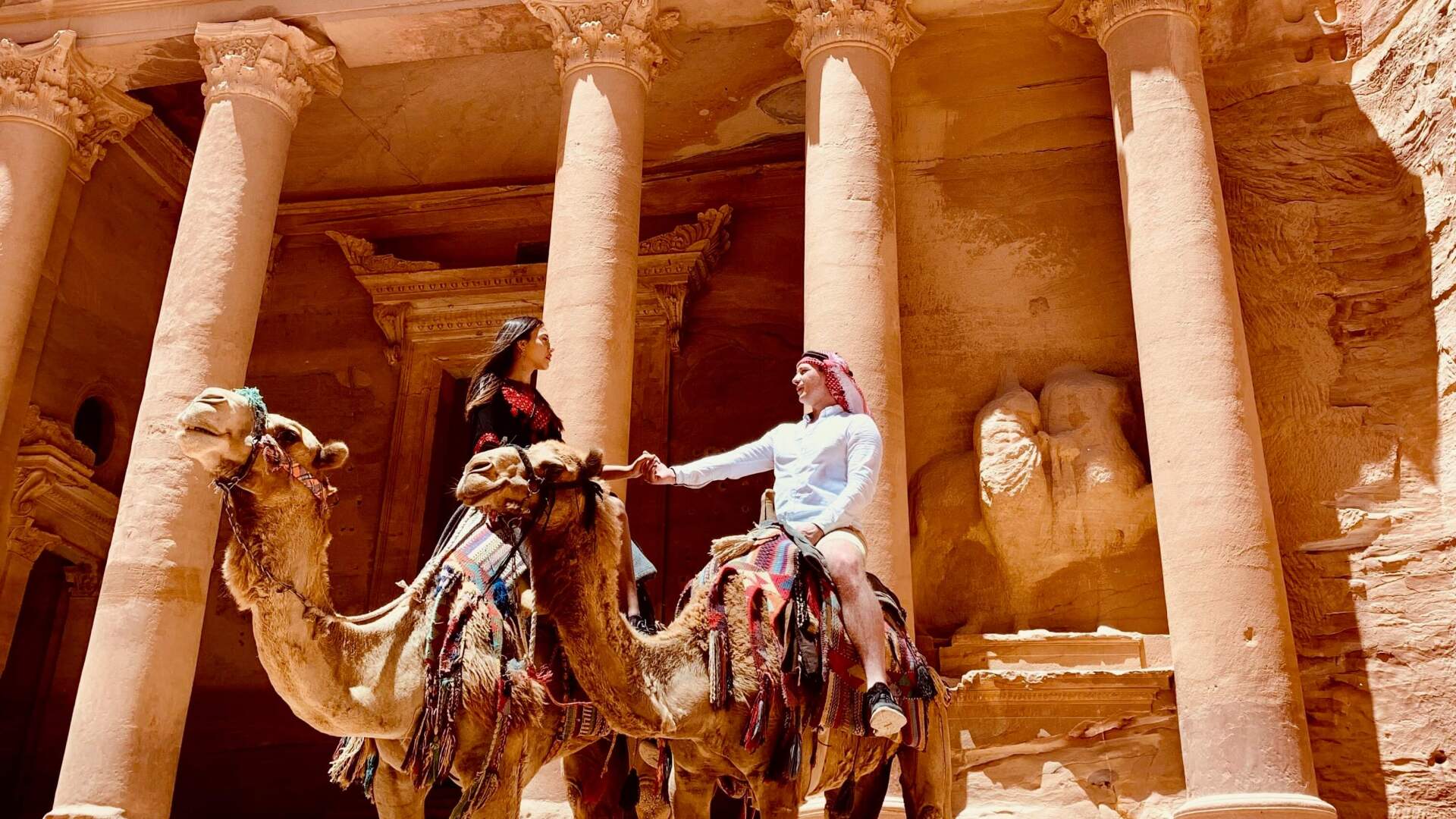Jordan Attractions & Highlights
Jordan is truly a land of spectacular culture, scenery and people. This tiny Arab Kingdom holds within its borders sites of antiquity that rank among the most exceptional in the world. The unique rose-red city of Petra; the outstanding remains of Jerash, one of the most magnificent Roman provincial cities. The remarkable vestiges of Umayyad palaces are built deep in the desert; the incredibly scenic Wadi Rum is permanently associated with Lawrence of Arabia.
-
Petra
The ancient city of Petra is one of Jordan's national treasures and, by far, its best-known tourist attraction. Petra is the legacy of the Nabataeans, an industrious Arab people who settled in southern Jordan more than 2,000 years ago. Petra is a UNESCO World Heritage Site and one of the new Seven Wonders of the World, admired for its refined culture, massive architecture and ingenious dams and water channels. This vast and unique city is carved into the sheer rock face by the Nabataeans, an industrious Arab civilisation, turning it into a critical junction for the silk, spice and other trade routes that linked China, India, and southern Arabia with Egypt, Syria, Greece, and Rome.
Much of Petra's appeal comes from its spectacular setting deep inside a narrow desert gorge. The site is accessed by walking through a kilometre-long chasm (or Siq) with walls that are 200 meters upwards. Petra's most famous monument, the Treasury, appears dramatically at the end of the Siq. The towering facade of the Treasury is only one of the myriad archaeological wonders to be explored.
Various walks and climbs reveal hundreds of buildings, tombs, baths, funerary halls, temples, arched gateways, collonaded streets, and a 3000-seat open-air amphitheatre. A gigantic first-century Nabatean Temple (the Monastery) and a modern archaeological museum can also be explored at leisure. A modest shrine commemorating the death of Aaron, brother of Moses, was built in the 13th century high atop mount Aaron in the Sharah range.
HIGHLIGHTS:
The Treasury from above - Enjoy a bird’s eye view of the Treasury by hiking the remote Al-Khubtha trail. This ancient stair-stepped trail will guide you from the Royal tombs up through amazing scenery overlooking the beautiful and impressive monuments and structures of Petra. You will reach an astonishing view of the Treasury with the opportunity of drinking refreshing Bedouin tea.
The High Place of Sacrifice - From the main trail after the Siq and the theatre, climb Jebel Madbah Mountain and reach the High Place of Sacrifice, Petra's best-preserved sacrificial site. The path to the altar of sacrifices is carved in the pink and orange sandstone cliffs and offers a spectacular view of Petra from the south.
The Monastery Route - Climb 1000 stairs to reach the Monastery, one of the best places to enjoy the timeless beauty of Petra. Contrary to the name suggests, the Monastery was never a monastery, as it was initially a Nabatean temple and later converted to a church. Recommended time for hiking is late afternoon when the trail is in the shade, and the Monastery façade glows orange in the setting sun.
-
Al-Beida & Little Petra
After or before your visit to Petra, plan a short trip to the nearby Al-Beida. This area is located only a ten-minute drive north of Petra and hosts two important highlights of Petra Archaeological Park: The Beida Neolithic Village and Little Petra.
The Neolithic Village in Al-Beida -One of the oldest sights in the Middle East and Human History. The Al-Beida Neolithic village is a unique archaeological site containing the remains of Pre-Pottery Neolithic human settlements. It has great historical and archaeological importance as it is considered one of the first settled areas in human history.
Little Petra - Little Petra site comprises a marvellous cluster of Nabatean architectures similar to those in Petra. The complex is believed to have been the first Nabatean settlement in Wadi Musa. The Nabateans established themselves along the Sig al-Barid, the "Cold Canyon" in Arabic, close to the Neolithic settlement. They carved their settlement into the sandstone cliffs and introduced sophisticated engineering solutions to bring water into the area. After the construction of their larger city at Petra, Al-Beida became an important suburb of Petra, serving as an agricultural centre and point of arrival and departure of caravans that traded along the ancient Silk Road connecting Petra with the East and the West. Many visitors skip the visit to Little Petra, so it usually remains uncrowded and calm. The few visitors can enjoy the magic of ancient buildings hidden for centuries in a relaxing atmosphere.
For hiking lovers, walking the Little Petra footpath is also possible. This 6-hour trail goes from Little Petra to Petra, passing through the Monastery.
-
Wadi Rum
Lawrence of Arabia, who established a base here during the Arab Revolt, defined the Wadi Rum desert with three adjectives that seem to fit well: vast, echoing and divine. Wadi Rum, or Valley of the Moon, truly has the appearance of another planet: large expanses of bright red sand in the midst of which rise high stone massifs that seem to emerge from nowhere. The region is home to the semi-nomadic Bedouins who live in goat hair tents, tend to their herds of sheep and goats and preserve a lifestyle practised here in the Arabian desert for centuries. It has also been used as a backdrop for many blockbuster movies. These include Lawrence of Arabia (1962), The Martian (2015), and most recently, Dune (2021)!
HIGHLIGHTS:
Jeep Tour - The local Bedouins manage the jeep tours, the true masters and the best experts of Wadi Rum. They will guide you through the area's hidden natural and archaeological beauties, such as the natural rock bridges of Umm Fruth or Buddha Arch, rock inscriptions and carvings in Khazali canyon, Lawrence’s spring and Lawrence’s ‘house’.
Camel Ride at Sunrise/Sunset - If you wish to experience the desert the same way as Bedouins and travellers did for centuries, you must take a camel ride. An experience does not get more authentic than this. Take a trip on a camel's back to watch the sunrise/sunset and have some Bedouin tea while taking in the magnificent ambience of Wadi Rum.
Hiking and Trekking - Our one of our Wadi Rum tours we offer opportunities for trekking and hiking for all nature lovers. Daily hikes with trained Bedouin guides will allow you to explore the iconic desert rocks and cliffs and get a closer look at the magnificent and often unnoticed flora and fauna. The hikes retrace ancient routes used by the tribes of the area to graze their livestock and trade with other tribes. Depending on the experience and fitness of the hikers, various options are available: short and easy daily mountain walks up to the Al-Shallaleh Spring above the Rum Village, all the way to a five-day trek into the desert.
Hot Air Balloon - A unique way to discover Wadi Rum is, without a doubt, by boarding the Wadi Rum hot air balloon. A tour usually lasts 2 to 3 hours, allowing visitors to view the astonishing desert sceneries.
Stargazing - The non-existent light pollution coupled with the emptiness and quietness of the desert make Wadi Rum one of the best places on Earth to enjoy breathtaking views of the stars and moon.
Join professional astronomers in a desert observatory to discover the cosmos on this fascinating tour. After an initial presentation, you'll explore the sky in two ways: tracing the constellations visible to the naked eye and using GPS-enabled telescopes to look at galaxies, nebulae & planets.
-
Amman
Amman is a modern, safe, and friendly capital city brimming with activity and has no end to exciting things to do. A striking feature of Amman is its delicately unique balance between the old and the new - often referred to as ‘the white city’ due to its canvas of white stone houses. Which makes an Amman city tour essential for your itinerary. The city is a unique blend of old and new, situated in a hilly area between the desert and the fertile Jordan Valley. Today, the city is thriving and has been crowned one of the world's most liberal Arab capitals, making it a very appealing destination for travellers. No more than a five-hour drive from anywhere in the country, it is a convenient place to start and end your Jordan Tour.
HIGHLIGHTS:
Local markets in downtown Amman - where you can sample traditional Middle Eastern snacks and haggle with vendors over spices, perfumes and jewellery.
Citadel Ruins - visit the remains of the Temple of Hercules, a Byzantine church and the Umayyad Palace. You can also visit the Archaeological Museum with artefacts from archaeological sites of the country.
The Roman Theatre - with its 6,000 seats, is situated on the hill opposite the Citadel. Here you can visit the Folklore Museum and the Museum of Popular Traditions, which form part of the theatre.
-
Jerash
A close second to Petra on the list of favourite destinations in Jordan is the ancient city of Jerash, which boasts an unbroken chain of human occupation dating back more than 6,500 years. Jerash lies on a plain surrounded by hilly wooded areas and fertile basins. Conquered by General Pompey in 63 B.C., it came under Roman rule and was one of the ten great Roman cities of the Decapolis League. The city's golden age came under Roman rule, during which time it was known as Gerasa, and the site is now generally acknowledged as one of the best-preserved Roman provincial towns in the world.
HIGHLIGHTS:
The Oval Plaza - The spacious plaza measures 90mx80m and is surrounded by a broad sidewalk and colonnade of 1st century A.D. Ionic columns. There are two alters in the middle, and a fountain was added in the 7th century A.D.
Collonaded Street / Cardo Maximus - Still paved with the original stones – the ruts worn by chariots are still visible – the 800m Cardo was Jerash's architectural spine and focal point. An underground sewage system ran the entire length of the Cardo, and the regular holes at the sides of the street drained rainwater into the sewers.
Hippodrome - This massive arena was 245m long and 52m wide and could seat 15,000 spectators at a time for chariot races and other sports. The exact date of its construction is unclear, but it is estimated between the mid-2nd to 3rd century A.D. It is now also possible to relive the days when gladiators and charioteers appeared before the crowds, with regular re-enactments by the Roman Army and Chariot Experience (RACE).
Hadrian’s Arch - Built to commemorate the visit of Emperor Hadrian to Jerash in 129 AD, this splendid triumphal arch was intended to become the main Southern gate to the city; however, the expansion plans were never completed.
Cathedral - Further up the Cardo Maximus, on the left, is the monumental and richly-carved gateway of a 2nd-century Roman Temple of Dionysus. In the 4th century, the temple was rebuilt as a Byzantine church, now called the 'Cathedral'.
Nymphaeum - This ornamental fountain was constructed in 191 AD and dedicated to the Nymphs. Such fountains were standard in Roman cities and provided a vital focal point for the city.
North & South Theatres – The North theatre was built in 165 AD, and in 235 AD, it was doubled in size to its current capacity of 1,600. The Southern theatre was built between 90 -92 A.D. and seated more than 3,00 spectators.
-
Ajloun Castle
A short journey west from Jerash (90min drive from Amman), through pine forest and olive groves, brings you to the Castle of Ajloun, also known as the Rabad castle. Ajloun is a fine example of Islamic architecture; the fortress dominated a vast stretch of the north Jordan Valley and its passages. The Castle was built in 1184 by the Ayyubids and had a highly strategic role. From its hilltop position, it protected the communications routes between south Jordan and Syria. The dialogue with other aligned fortresses was possible through a complex communication system involving fire signalling and carrier pigeons capable of connecting Damascus and Cairo in twelve hours.
The Castle hides a labyrinth of covered passageways, spiral staircases, long ramps, rooms used as dining rooms, bedrooms, and stables, as well as private areas intended for the lords of the Castle (equipped with a small stone basin and windows with slits). There is also a small museum with collections of ancient objects.
Venture through the solid walls and passages of the Castle and immerse in its history. Caressed by the wind, enjoy the spectacular panorama on the top of the Castle.
-
Al-Salt
Al-Salt is one of the oldest cities of Jordan and the old capital during the Ottoman period. Situated at 790–1100 meters above sea level, about 35 minutes drive from Amman, many rulers chose it as a settlement area and stronghold. That was due to its strategically convenient position halfway between the Jordan Valley and the eastern desert - at the centre of the ancient trade route connecting the east and the west. The area is also known for its fertile soil, which produces the tastiest fruits and vegetables in the region, mainly olives, tomatoes, grapes, and peaches. The name "Salt" probably originates from the word sultana, a certain type of raisin. The UNESCO World Heritage Committee added Al-Salt, "the place of tolerance and urban hospitality", to its World Heritage List to become the sixth Jordanian landmark to be declared a UNESCO world heritage site.
HIGHLIGHTS:
Salt Archaeological Museum: Salt Archaeological Museums is among the most informative museums in Jordan, providing the visitor with insightful details about the history of the Jordan Valley and the Balqa region, as well as the culture and traditions of the area.
But Abu Jaber Museum - The Beit Abu Jaber Museum is an old house dating from 1890 that has been recently converted into a historical museum by a project of the Ministry of Tourism.
The Shrines of Prophet Joshua/Yeshua - This is the grave of Prophet Joshua, an important historical and religious figure as a student and successor of Prophet Moses and leader of the Israelites during the conquest of Canaan. The shrine is located inside a mosque and is easily reachable from the city centre.
-
Madaba
Madaba is situated on the king’s highway, 40 km south of Amman and is built on the ruins of biblical Medeba. It is famed for its mosaics dating from the Byzantine era, many of which are located in private homes. They were discovered when owners dug the foundations, which led to Madaba's designation as "the city of mosaics." The map of the holy land at St. George's church dates from the 6th century A.D. and is the most preserved of its kind in the world. Its clarity and precision helped archaeologists discover many other important sites in Jordan and the West Bank. This map was originally part of the floor of a Byzantine church, built during the reign of emperor Justinian, 527-565 A.D.
One of the highlights to visit is the Church of the Apostles, where they discovered one of the most treasured mosaic creations in the area. The mosaic is dedicated to the 12 Apostles and is the only place where the craftsman's name is included. Created in AD 568, the art boasts an array of colours and whimsical pictures of animals, flowers, birds, and fruits. Another monument worth visiting is the Church of the Beheading of John the Baptist, the early 20th-century Roman Catholic Church that has enchanted pilgrims and visitors from across the globe. At the heart of the structure is the Acropolis Museum, where a well dating 3,000 years back is still fully functional. The design, complete with its Roman columns, is still remarkably shaped.
Madaba is known for its delightfully vibrant and lush produce. Visitors are urged to sample olive oil freshly pressed in the area. The food scene is one of the liveliest in the city.
The Madaba's downtown market area is a souvenir shopper's dream. From handmade trinkets to elegantly designed home accessories, the shopping experience is truly remarkable. The city is best known for its handmade carpets and tapestries, often produced on-site for potential customers. Watching carpet makers working their fingers through the weaving machine has a hypnotising effect.
HIGHLIGHTS:
St George’s Church & Mosaic Map - On this site, you will see the masterpiece of Madaba (a Byzantine mosaic map of the Holy Land that goes back to the 6th century, showing Jerusalem and other cities)
Madaba Archaeological Park I & Virgin Mary Church - This archaeological park includes the fantastic mosaics of the church of the virgin, which was built in the 6th century, Also the remains of several Byzantine churches.
-
Mount Nebo
Mount Nebo is located on a hill and provides panoramic views of Israel and Jericho across the valley and even Jerusalem on clear days if the weather allows it. According to the Old Testament, Moses saw the Promised Land (Israel) from Mount Nebo, and it was also where God buried Moses according to the Christian tradition. A Mount Nebo tour includes venturing inside the Monastery and taking in the mosaic works, specifically the central mosaic, which measures 3 by 9 meters and captures different aspects of monastic life. Once outside the Monastery, admire the large serpentine cross, a figure representing the serpent taken by Moses.
HIGHLIGHTS:
Moses Memorial Church with the splendid Byzantine mosaics: Erected on top of Mount Nebo around the foundations of the old 4th-century byzantine church, Moses Memorial Church is the most significant highlight of Mount Nebo. It contains basilicas, baptisteries, and impressive mosaics dating back to the byzantine area.
Brazen Serpent Monument: Outside the Monastery, near the balcony overlooking the panorama, there is a bronze sculpture by the Florentine artist Gian Paolo Fantoni, representing a snake twisting around a stick, forming a stylised cross. It symbolises the serpent that Moses raised in the desert and the crucifixion of Christ.
Panorama of Holy Land: Mount Nebo is the place where God showed Moses the Promised Land for the first time (Deuteronomy 34). The best place to admire the breathtaking scenery described in ancient religious texts is the terrace outside the Basilica. It is possible to see the Dead Sea and Israel on clear days.
-
The Dead Sea
At the northern end of the Great Rift Valley lies the Jordan Valley, the lowest point on the surface of the Earth and fascinating natural phenomena. The Dead Sea is more than 400 meters below sea level and straddles the border between Israel and Jordan. The mineral content of this saltwater lake (75 km long x 10 km wide) is 33%, which is about six times as salty as the ocean. This incredibly high salt content means the Dead Sea is highly buoyant, making it impossible to sink or swim in - the only option is to bob around like a cork! It's called the Dead Sea, as nothing can live in it. Treat yourself to a soothing massage or experiment with the renowned healing powers of minerals from the Sea's muddy floor. The valley is typically Mediterranean, with mild winters and hot summers.
-
Aqaba
With its balmy winter climate and idyllic setting, Aqaba is Jordan’s year-round aquatic playground. The thriving underwater marine life and the crystal clear waters of the Gulf of Aqaba make diving conditions there among the acknowledged best in the world. As the Gulf of Aqaba is an inland sea with few strong currents, its waters remain warm and clear throughout most of the year. Conditions are ideal for underwater photography, and a lavish array of exotic fish and plant life makes for excellent snorkelling and diving. Over 140 species of coral have been identified in Aqaba's waters, making it important for your Aqaba and Petra tour plans. Sunbathing, water skiing, windsurfing, fishing, paddleboats, and other water sports are also popular.
HIGHLIGHTS:
Watersports: There’s no denying that Aqaba’s greatest asset is the Red Sea, not least because it offers something for every type of visitor. Chill out and get pampered on the beach, go wild with a waterskiing lesson or a parasailing flight, or keep your feet dry with any number of glass-bottom boat tours. Neptune Boat trips take you under the water in a submarine for spectacular views of the natural aquarium beneath the surface.
Diving: For most visitors to Aqaba, it's all about diving. Choose from 23 dive sites, most of which are within the boundaries of the Aqaba Marine Park, an organisation responsible for protecting the coral reefs and maintaining safety standards.
Shopping: Savvy shoppers will know that Aqaba is a duty-free zone, so shopping here is cheaper than in the rest of Jordan (you'll even get the best prices on Dead Sea skincare ranges). Shops and stalls all over town offer handcrafted pottery, glass, textiles, and traditional Bedouin jewellery made by local craftspeople. Still, some of the best souvenirs of Aqaba are found at the spice stalls and nut shops.
-
Baptism Site & Elijah’s Hill
Home to several biblical cities, including Sodom, Gomorrah, and Zoar, the archaeological discoveries between the Jordan River and Tal al-Kharar have identified this area as Biblical "Bethany Beyond the Jordan." The area is where John was living when he baptised Jesus. Designated as a UNESCO World Heritage site, the Baptism Site commission welcomes pilgrims from around the world seeking spiritual connection to biblical times, a glimpse of history, or a chance to be baptised where Jesus was so many years ago. One of the most important sites of the Baptism Site is Elijah’s Hill, the place where Elijah ascended to heaven in the 9th century B.C. The Bible states that Elijah would return before the coming of Jesus, so when John the Baptist began baptising people there, it caused a massive stir in the surrounding villages. On the western side of Elijah's Hill is a cave where John lived and where Jesus visited him. It is considered a very holy site; therefore, a church was built around the Cave when the Monastery was built in the 5th century. It was the first monastery east of the Jordan River on the early Christian pilgrimage route between Jerusalem and Bethlehem to the west and Mount Nebo to the East. Visually the site is very similar to how it would have looked in the time of Jesus and John. The Bible describes the reeds that can be seen throughout the year today. The small rough bushes are the natural habitat for bees, reminding us of what John the Baptist used to eat, wild honey and locusts.
-
Lot’s Cave
South of the Dead Sea and near the village of Safi (Biblical Zoar) is Lot's Cave, a stiff 10-minute climb up a steep flight of steps, is surrounded by the ruins of a small Byzantine church (5th to 8th centuries), a reservoir and some mosaics. Remains from the cave date to the early Bronze Age (3300–2000 B.C.), and an inscription in the Cave mentions Lot by name. Lot's Cave is where he and his daughters are said to have lived after fleeing the destruction of Sodom and Gomorrah. The site is one of Jordan’s UNESCO world heritage sites. Lot’s Cave Museum - located 1,329 feet below sea level at the southern edge of the Dead Sea, the aptly-named ‘Museum at the Lowest Place on Earth’ feature important archaeological finds recovered from the Ghor es-Safi region of Jordan (ancient Zoar/Zoora), including artefacts from Lot's Cave.
Jordan Tours
JORDAN SMALL GROUP TOURS
GROUP TOUR
7 days/ 6 nights
Highlights: Amman, Petra, Wadi Rum, Dead Sea
Date: Oct & Nov 2023
PILGRIMAGE TOUR
8 days/ 7 nights
Highlights: Um Qais, Bethany, Lot’s Cave, Mt Nebu, Petra & Wadi Rum
Date: Private Tour
HIKING & HIGHLIGHTS TOUR
11 days / 10 nights
Highlights: Amman, Dead Sea, Dana Reserve, Petra, Wadi Rum
Date: Private tour
ROMANTIC JORDAN
8 days / 7 nights
Highlights: Amman, Dead Sea, Petra, Wadi Rum
Date: Private Tour


